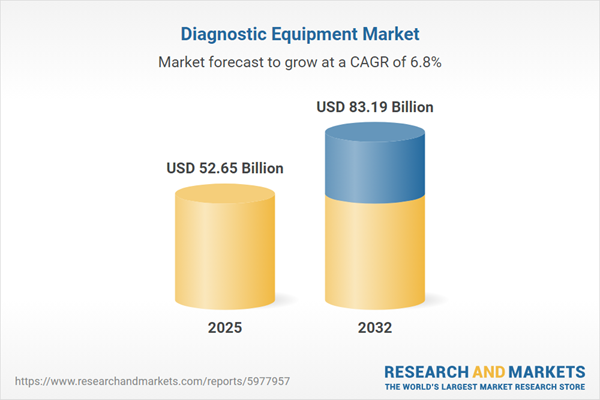Speak directly to the analyst to clarify any post sales queries you may have.
The diagnostic equipment market is rapidly evolving as healthcare providers seek technologies that support precision, efficiency, and better patient outcomes. Senior decision-makers need sound, actionable intelligence to successfully navigate advancements, regulatory shifts, and expanding demands across global healthcare systems.
Market Snapshot: Diagnostic Equipment Market Growth and Forecast
The diagnostic equipment market is set for robust growth, with revenue projected to rise from USD 49.27 billion in 2024 to USD 52.65 billion by 2025, indicating a compound annual growth rate (CAGR) of 6.76%. By 2032, forecasts expect the market to reach USD 83.19 billion.
Key drivers include a stronger focus on early disease diagnosis and more integrated diagnostic workflows. Heightened demand for timely, accurate testing impacts both mature and emerging healthcare economies, prompting ongoing innovation and compliance. Organizations must differentiate through portfolio expansion and adjustment to diverse regulations, leveraging advancements to address both centralized and point-of-care needs while balancing local market requirements.Scope & Segmentation of the Diagnostic Equipment Market
- Product Types: Blood gas and electrolyte analyzers, hematology and coagulation systems, immunoassay platforms, microbiology tools, PCR and molecular diagnostic equipment, and advanced urinalysis devices span a variety of clinical and near-patient applications. Each product type is designed to address specific diagnostic challenges, supporting laboratories and healthcare professionals in routine and complex case management.
- Technologies: Chromatography, flow cytometry, mass spectrometry, immunoassay, and PCR-based methods enable high-precision diagnostics with rapid turnaround. These technologies are integral for data-driven clinical decisions and expanding diagnostic scope in both hospital and decentralized settings.
- Applications: Solutions are critical for cardiology, diabetes monitoring, oncology, infectious disease detection, genetic screening, and prenatal diagnostics. Applied across multiple specialties, they enable healthcare organizations to address wide-ranging clinical needs and streamline patient care workflows.
- End Users: Diagnostic laboratories, clinics, hospitals, academic centers, and point-of-care locations drive adoption to enhance diagnostic access and treatment quality. Their differing capacities and requirements influence purchasing patterns and the types of solutions integrated.
- Sales Channels: Distribution models include direct contracts, supply agreements, and digital procurement pathways, offering flexibility for buyers to adapt to changing operational environments and regional procurement dynamics.
- Regions Covered: North America, Latin America, Europe, Middle East and Africa, and Asia-Pacific each present unique healthcare infrastructure and adoption patterns. Market dynamics reflect differences in regulatory policies, resource allocation, and clinical needs, shaping vendor strategies and innovation focus.
- Key Industry Players: F. Hoffmann-La Roche AG, Abbott Laboratories, Danaher Corporation, Siemens Healthineers AG, Thermo Fisher Scientific Inc., Becton Dickinson and Company, bioMérieux SA, Sysmex Corporation, Ortho Clinical Diagnostics Inc., and QIAGEN N.V. shape industry direction through continual investment in research, technology, and regional outreach. Their diverse portfolios address the evolving needs of global healthcare clients.
Key Takeaways for Senior Decision-Makers
- Advancement of AI-driven and compact diagnostic platforms accelerates point-of-care testing and supports confident clinical decision-making in dynamic healthcare settings.
- Improved interoperability between diagnostic systems and electronic health records can streamline care coordination, reducing administrative burden and supporting seamless patient data sharing.
- Automation in diagnostic technology highlights the significance of standardized protocols and international compliance frameworks, safeguarding consistency and reliability.
- Modular and scalable system designs provide operational agility, enabling quick adaptation to evolving patient volumes and shifting clinical priorities.
- Expansion of cloud-based analytics increases the importance of a strong data privacy posture, requiring diligent adherence to security and governance protocols during digital transitions.
- Collaborative partnerships among equipment vendors, digital health innovators, and life sciences companies are extending diagnostic capabilities and broadening access to underserved markets worldwide.
Tariff Impact: Global Trade and Supply Chain Optimization
Ongoing changes in U.S. tariff policy are prompting diagnostic equipment manufacturers to review their sourcing, manufacturing, and supplier relationships. Localizing production and reinforcing supply chains can minimize operational risk and help maintain reliable product flow, supporting continuity across B2B partnerships and healthcare delivery networks.
Methodology & Data Sources
This market analysis is grounded in peer-reviewed medical literature, regulatory publications, and comprehensive industry datasets. Insight from structured executive interviews with healthcare and laboratory leaders further validates the findings, ensuring all data supports informed strategic planning and high business accuracy.
Diagnostic Equipment Market: Why This Report Matters
- Delivers practical insights into diagnostic equipment market trends, giving leadership the tools to shape effective procurement and strategic plans.
- Presents clear segmentation and core market drivers, supporting proactive decision-making in response to changing industry demands and compliance requirements.
- Equips healthcare enterprises with timely intelligence to strengthen market position and mitigate risks in an environment of continuous transformation.
Conclusion
Continuous investment in diagnostic equipment supports healthcare organizations with the flexibility and innovation needed to address emerging challenges while consistently raising standards of care and operational performance.
Additional Product Information:
- Purchase of this report includes 1 year online access with quarterly updates.
- This report can be updated on request. Please contact our Customer Experience team using the Ask a Question widget on our website.
Table of Contents
3. Executive Summary
4. Market Overview
7. Cumulative Impact of Artificial Intelligence 2025
Companies Mentioned
The companies profiled in this Diagnostic Equipment market report include:- F. Hoffmann-La Roche AG
- Abbott Laboratories
- Danaher Corporation
- Siemens Healthineers AG
- Thermo Fisher Scientific Inc.
- Becton, Dickinson and Company
- bioMérieux SA
- Sysmex Corporation
- Ortho Clinical Diagnostics, Inc.
- QIAGEN N.V.
Table Information
| Report Attribute | Details |
|---|---|
| No. of Pages | 180 |
| Published | November 2025 |
| Forecast Period | 2025 - 2032 |
| Estimated Market Value ( USD | $ 52.65 Billion |
| Forecasted Market Value ( USD | $ 83.19 Billion |
| Compound Annual Growth Rate | 6.7% |
| Regions Covered | Global |
| No. of Companies Mentioned | 11 |









